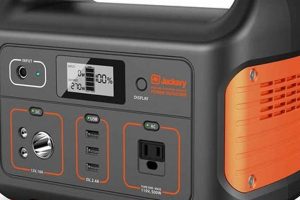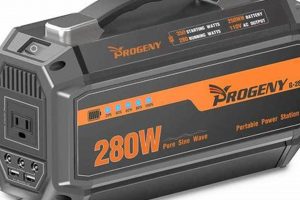Determining the appropriate size of a portable generator involves calculating the combined wattage requirements of the appliances and devices intended for simultaneous use. For example, a homeowner might need to power essential items like a refrigerator (150-250 watts), a furnace fan (500-1000 watts), and several lights (60 watts each) during a power outage. Adding these wattages provides an initial estimate, which should then be adjusted upwards by 10-20% to account for starting wattage surges.
Accurate power assessment is crucial for several reasons. An undersized generator may overload and shut down, leaving critical systems without power. Conversely, an oversized generator consumes more fuel and increases operating costs unnecessarily. Historically, generator sizing relied heavily on rough estimations, but advancements in appliance efficiency and the proliferation of electronics have made precise calculations increasingly important for both cost-effectiveness and reliability.
This understanding of power calculation forms the basis for exploring various aspects of generator selection and usage, including load management strategies, generator types, and safety considerations.
Tips for Accurate Power Assessments
Accurately assessing power requirements is essential for selecting a suitable portable generator. The following tips offer guidance for this crucial process.
Tip 1: Inventory Appliances: Create a comprehensive list of all devices requiring power during an outage. This inventory should include essential appliances, electronics, and tools.
Tip 2: Determine Running Wattage: Identify the running wattage of each item. This information is typically found on an appliance’s label or in its user manual. Online resources can also provide wattage estimates.
Tip 3: Account for Starting Wattage: Starting wattage, the initial surge of power required to start a motor, can be significantly higher than running wattage. Multiply the running wattage of motor-driven appliances (refrigerators, pumps) by a factor of three to estimate starting wattage.
Tip 4: Calculate Total Wattage: Sum the running wattages of all intended devices. Add the highest starting wattage from among the appliances to this sum. This total represents the minimum generator capacity required.
Tip 5: Incorporate a Safety Margin: Add a safety margin of 10-20% to the calculated total wattage. This buffer accounts for unforeseen power fluctuations and potential future needs.
Tip 6: Consider Load Management: Prioritize essential appliances and stagger their usage to avoid exceeding the generator’s capacity. For instance, avoid running the microwave oven while the refrigerator’s compressor is cycling.
Tip 7: Consult Manufacturer Specifications: Review the generator manufacturer’s recommendations for specific appliance types. Some appliances may have unique power requirements.
Following these tips ensures the selection of a properly sized generator, maximizing efficiency and preventing overloads. A well-chosen generator provides reliable power during outages, protecting both appliances and peace of mind.
Through careful planning and accurate calculations, consumers can make informed decisions when selecting a portable generator appropriate for their specific needs.
1. Wattage Calculation
Accurate wattage calculation forms the cornerstone of effective portable generator sizing. Understanding power demands ensures the generator can handle the anticipated load, preventing overloads and ensuring sufficient power during outages. This process involves identifying individual appliance wattages and aggregating them to determine the total power requirement.
- Appliance Inventory
Creating a comprehensive inventory of appliances intended for use during a power outage is the first step. This inventory should list each appliance, its running wattage (the power consumed during normal operation), and its starting wattage (the brief surge of power required to start the appliance, particularly relevant for motor-driven devices). For example, a refrigerator might have a running wattage of 150 watts and a starting wattage of 450 watts.
- Running Wattage Summation
After compiling the inventory, sum the running wattages of all appliances intended for simultaneous use. This provides the baseline power requirement the generator must meet continuously. For instance, if a homeowner intends to power a refrigerator (150W), a furnace fan (700W), and several lights (60W each, totaling 180W), the summed running wattage is 1030 watts.
- Starting Wattage Consideration
Incorporate the highest starting wattage from the appliance inventory. Since appliances don’t all start simultaneously, it’s generally sufficient to account for the single largest starting wattage demand. Continuing the previous example, if the furnace fan has the highest starting wattage of 1400 watts, this value is added to the calculation.
- Safety Margin Implementation
Finally, add a safety margin of 10-20% to the calculated total. This buffer accounts for potential power fluctuations, unforeseen loads, and future appliance additions. Applying a 15% safety margin to the 2430 watt total (1030W running + 1400W starting) results in a final estimated requirement of approximately 2795 watts.
Through meticulous wattage calculation, consumers can select a portable generator that matches their power needs. This process ensures reliable power delivery during outages, prevents generator overload, and optimizes resource utilization.
2. Starting vs. Running Watts
Understanding the distinction between starting watts and running watts is crucial for accurately estimating power needs and selecting an appropriately sized portable generator. Starting watts represent the surge of power required to initiate operation, particularly for motor-driven appliances, while running watts reflect the power consumed during sustained operation. Accurate assessment of both values is essential for preventing generator overload and ensuring reliable power delivery.
- Starting Watts Surge
Motor-driven appliances, such as refrigerators, air conditioners, and pumps, require a significantly higher initial power surge to start their motors. This surge, known as starting wattage, can be two to three times higher than the appliance’s running wattage. For instance, a refrigerator with a running wattage of 150 watts might require a starting wattage of 450 watts. Failure to account for this surge can lead to generator overload and shutdown.
- Running Watts Demand
Running watts represent the continuous power consumed by an appliance during normal operation. This value is typically lower than the starting wattage and reflects the power required to maintain the appliance’s function. Accurately assessing running watts is essential for determining the generator’s sustained power delivery capacity.
- Impact on Generator Selection
Both starting and running watts play critical roles in generator selection. The generator’s starting wattage capacity must exceed the highest starting wattage of any individual appliance intended for use. The generator’s running wattage capacity must exceed the sum of the running wattages of all appliances planned for simultaneous operation. Inadequate consideration of either value can result in insufficient power supply or generator damage.
- Practical Application Example
Consider a scenario requiring the simultaneous operation of a refrigerator (150W running, 450W starting), a furnace fan (700W running, 1400W starting), and several lights (180W running, negligible starting). The generator must accommodate the highest starting wattage (1400W) and the total running wattage (1030W). A generator with a running wattage capacity of at least 1200W (including a safety margin) and a starting wattage capacity exceeding 1400W would be suitable.
Accurately differentiating and applying starting and running wattage values is fundamental to effective portable generator selection and ensures reliable power delivery during outages. This understanding enables users to match their power needs with the appropriate generator capacity, preventing overloads and maximizing efficiency.
3. Appliance Prioritization
Appliance prioritization plays a critical role in effectively utilizing portable generators. Matching power supply with essential needs ensures efficient resource allocation during outages. Prioritization informs generator sizing decisions and facilitates load management strategies, optimizing performance and extending generator lifespan.
- Essential vs. Non-Essential Appliances
Distinguishing between essential and non-essential appliances is fundamental. Essential appliances, such as refrigerators, medical equipment, and heating systems, maintain critical functions during outages. Non-essential appliances, like entertainment systems and non-critical lighting, can be temporarily forgone. This distinction guides generator sizing by focusing on powering essential loads. For example, a homeowner might prioritize powering a refrigerator and furnace over a television during a winter storm.
- Power Consumption Hierarchy
Establishing a power consumption hierarchy further refines prioritization. Within essential appliances, some may consume more power than others. A homeowner might choose to operate a refrigerator continuously, while cycling a sump pump only intermittently, reducing the simultaneous power demand. Understanding the wattage requirements of each appliance informs this hierarchy. A well-defined hierarchy allows for strategic load management, ensuring the generator operates within its capacity.
- Phased Power Restoration
Prioritization enables phased power restoration within a household. Once essential loads are stabilized, less critical appliances can be reintroduced incrementally as generator capacity allows. This phased approach prevents overloading the generator and maximizes its operational efficiency. It also provides flexibility in managing power consumption during extended outages.
- Impact on Generator Sizing
Appliance prioritization directly impacts generator sizing estimations. By focusing on powering only essential loads, a smaller, more cost-effective generator may suffice. This targeted approach avoids the unnecessary expense and fuel consumption associated with oversized generators. Accurately prioritizing needs optimizes generator selection and resource utilization.
By prioritizing appliances based on necessity and power consumption, consumers can optimize generator usage during outages. This strategic approach ensures essential functions remain operational while maximizing generator efficiency and minimizing fuel consumption. Effective appliance prioritization is therefore integral to successful power management during emergency situations.
4. Safety Margin
A safety margin, also known as a reserve capacity, plays a vital role in accurately estimating power needs for portable generators. It represents a buffer added to the calculated total wattage requirement, ensuring the generator can handle unforeseen fluctuations, temporary surges, and potential future load increases. Implementing a safety margin protects against overloads, extends generator lifespan, and provides operational flexibility.
- Unforeseen Power Fluctuations
Power demands can fluctuate unexpectedly due to variations in voltage, appliance cycling, and environmental factors. A safety margin accommodates these fluctuations, preventing the generator from becoming overloaded and shutting down. For example, a sudden voltage drop could increase the current draw of appliances, exceeding the generator’s capacity if a safety margin isn’t incorporated. The margin provides a buffer against these unpredictable variations, ensuring continuous power supply.
- Temporary Starting Wattage Surges
While calculations typically account for the highest starting wattage of individual appliances, simultaneous or near-simultaneous starting of multiple devices can create a cumulative surge exceeding initial estimates. A safety margin absorbs these transient surges, preventing generator overload. For instance, if a refrigerator and a well pump cycle on within a short time frame, the combined starting wattage could momentarily exceed the generator’s capacity if a safety margin is absent. The margin provides a buffer against these combined surges.
- Future Load Increases
Power needs may evolve over time due to the acquisition of new appliances or changes in usage patterns. A safety margin anticipates these future increases, avoiding the need for generator replacement or upgrades. For example, a homeowner might later purchase a power tool or additional electronic devices, increasing the overall load. A safety margin incorporated during initial calculations accommodates these future additions, extending the generator’s usability.
- Generator Lifespan and Efficiency
Operating a generator consistently near its maximum capacity reduces its lifespan and decreases fuel efficiency. A safety margin allows the generator to operate at a lower percentage of its rated capacity, reducing strain, improving fuel economy, and extending its operational life. This margin provides a buffer against continuous high-load operation, maximizing the generator’s longevity and performance.
By incorporating a safety margin of typically 10-20%, individuals ensure the selected generator can handle unforeseen circumstances, future load increases, and transient power surges. This proactive approach safeguards against overloads, maximizes generator lifespan, and provides a crucial buffer for reliable power delivery during outages. A safety margin, therefore, represents a critical component of responsible generator sizing and power management.
5. Load Management
Load management is intrinsically linked to estimating power needs for portable generators. Accurate power estimation provides the foundation for effective load management strategies, ensuring the generator’s capacity isn’t exceeded while maximizing the utilization of available power. This involves strategically managing the timing and combination of appliance usage to balance power demand with generator output. Without a clear understanding of power needs, effective load management is impossible, potentially leading to overloads, generator damage, and power interruptions. Load management essentially bridges the gap between estimated power needs and actual power usage, ensuring the generator operates safely and efficiently.
For example, consider a household with a generator capable of supplying 3000 running watts. If estimated power needs include a refrigerator (150W), a furnace fan (700W), and several lights (180W), simultaneous operation poses no issue. However, adding a microwave oven (1500W) to the mix exceeds the generator’s capacity. Effective load management dictates avoiding simultaneous use of high-wattage appliances. The homeowner could operate the microwave while other high-wattage appliances are off, preventing overload and ensuring continuous power for essential needs. This illustrates the practical significance of load management as a direct application of accurate power estimation. Staggering usage maximizes available power, allowing for operation of various appliances within the generator’s limitations.
Effective load management hinges on precise power estimation. This understanding empowers users to make informed decisions about appliance usage during outages, maximizing generator efficiency and preventing overloads. Load management acts as a practical application of power estimations, ensuring the generator’s capabilities are aligned with actual power demands. Challenges arise when estimations are inaccurate or load management strategies are not implemented. Overloads can damage the generator and interrupt power supply, underscoring the importance of accurate power assessment and strategic load management as integral components of portable generator usage.
Frequently Asked Questions
Addressing common inquiries regarding power needs assessment for portable generators clarifies the process and facilitates informed decision-making.
Question 1: How does one determine the wattage requirements of individual appliances?
Wattage information is typically found on appliance labels or in user manuals. Online resources and manufacturer websites also provide wattage data for various appliance models. If wattage information isn’t readily available, contacting the manufacturer directly may be necessary.
Question 2: What is the significance of starting wattage, and how does it differ from running wattage?
Starting wattage represents the initial power surge required to start an appliance’s motor, often significantly higher than the running wattage needed for sustained operation. Generators must accommodate both the highest starting wattage of any single appliance and the combined running wattage of all intended appliances.
Question 3: Is it advisable to operate a generator at its maximum capacity?
Continuously operating a generator at its maximum capacity is generally discouraged. Doing so can shorten the generator’s lifespan, reduce fuel efficiency, and increase the risk of overheating. A safety margin ensures the generator operates below its maximum capacity, promoting longevity and reliability.
Question 4: How does one account for potential future increases in power needs?
Incorporating a safety margin of 10-20% when calculating total wattage accounts for potential future power needs. This margin provides flexibility for adding new appliances or increasing usage without requiring immediate generator replacement.
Question 5: What are the consequences of underestimating power needs when selecting a generator?
Underestimating power needs can lead to generator overload, causing it to shut down and potentially damaging connected appliances. An undersized generator may not provide sufficient power for essential needs during an outage.
Question 6: What role does load management play in generator operation?
Load management involves strategically scheduling appliance usage to avoid exceeding the generator’s capacity. Prioritizing essential appliances and staggering their operation maximizes available power and prevents overloads.
Accurate power estimation is paramount for selecting and operating portable generators effectively. Careful consideration of these factors ensures reliable power delivery during outages and maximizes generator lifespan.
Moving forward, practical examples of power estimation scenarios provide further clarity and demonstrate real-world applications.
Conclusion
Accurately estimating power needs for portable generators is crucial for ensuring reliable power delivery during outages. This process involves meticulous calculation of appliance wattages, differentiation between starting and running watts, strategic appliance prioritization, incorporation of a safety margin, and implementation of effective load management strategies. Each of these components contributes to a comprehensive understanding of power requirements, enabling informed generator selection and optimized performance. Neglecting any of these aspects can lead to generator overload, shortened lifespan, inefficient fuel consumption, and ultimately, failure to provide essential power during emergencies.
The ability to accurately estimate power needs empowers individuals and communities to navigate power outages effectively. Preparedness through careful planning and precise calculations ensures access to reliable backup power, mitigating the impact of disruptions and safeguarding essential operations. This proactive approach to power management is critical for maintaining safety, productivity, and peace of mind during unforeseen circumstances. Investment in proper generator sizing and load management practices translates to a robust and resilient power infrastructure, capable of weathering unforeseen challenges.






